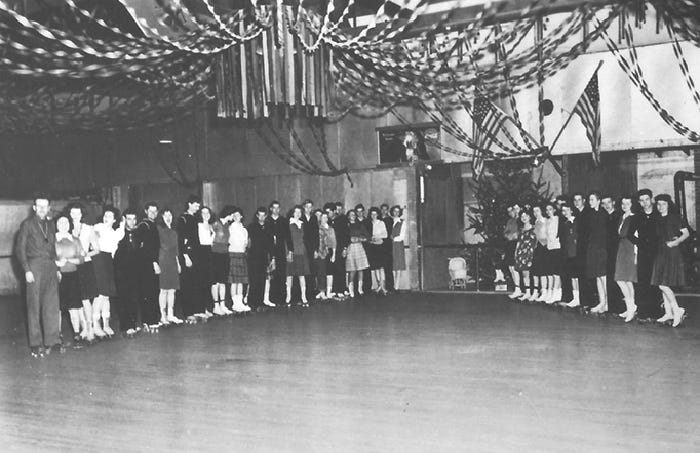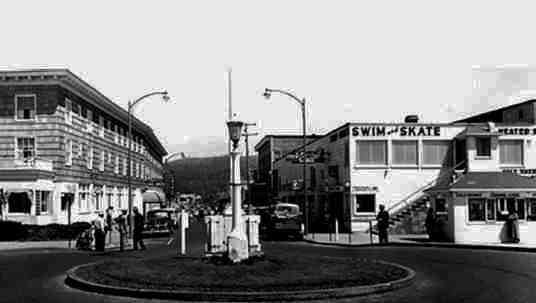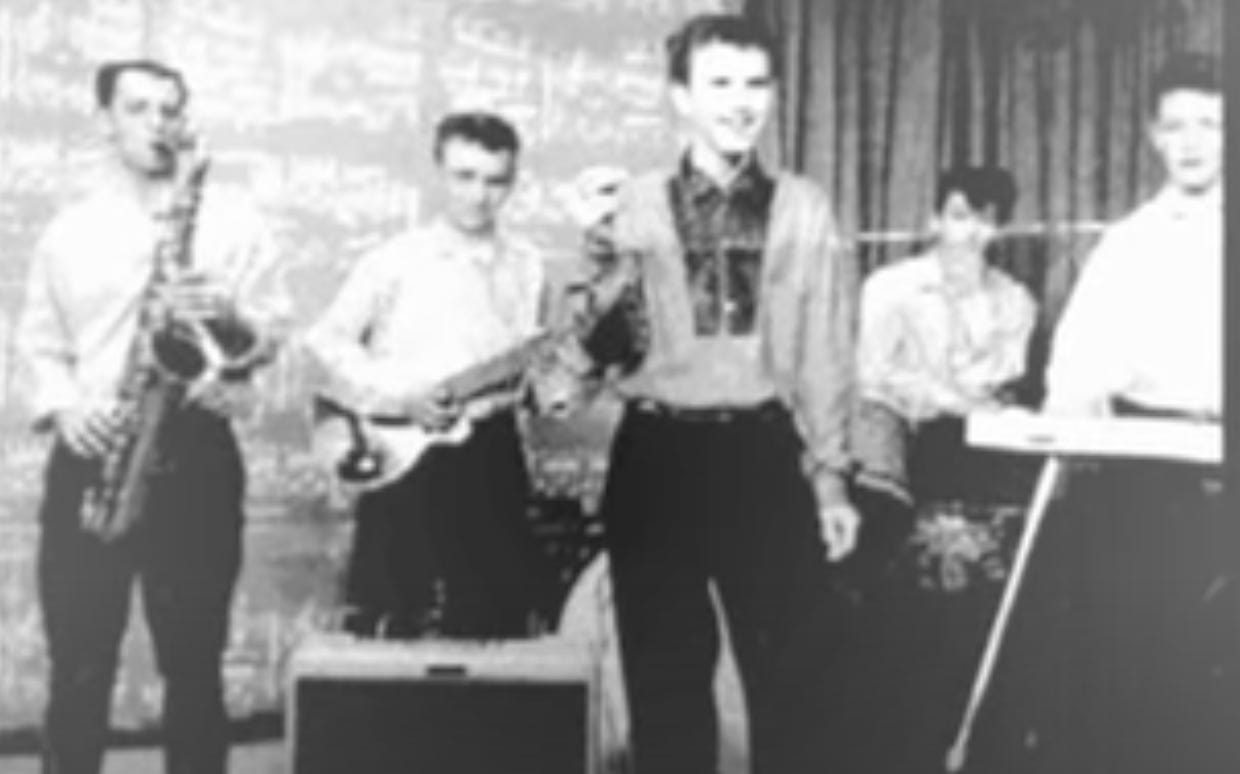FBI director J. Edgar Hoover compiled a dossier on Seaside’s Labor Day riots of 1962, 1963 and 1964. “Meet the Press,” the long-running NBC-TV news show, contemplated the topic in its immediate aftermath. 1964 presidential candidate Barry Goldwater used footage from the riots to draw support for his law-and-order campaign. Editorial writers from coast to coast lamented the scourge overtaking youth.
Three years of Labor Day riots — 1962, 1963 and 1964 — could be characterized as a mash-up of beach movie, national youth unrest, with a hefty dose of small-town City Hall drama.
In the post-World War II years, Seaside had grown as a tourist destination and pleasure center. Seaside’s glory days came in the postwar years.
Dancers flocked to the Bungalow, one block west of the Promenade at Columbia Street and Broadway, where world-class big bands like Duke Ellington, Glenn Miller and Jimmie Lunceford (who died while in Seaside in July 1947) performed and drew fans from Portland, Seattle and beyond.
The Miss Oregon contest came to Seaside in 1947, further establishing itself as the Atlantic City of the West Coast.
Throughout the late 1940s and 1950s, the regions witnessed a transition in the economy from the traditional logging and fishing industries, with tourism assuming a preeminent role. In Seaside, the main street, Broadway was filled with honky-tonks, bars and clubs. The city catered to the more elegant diners at the Crab Broiler on U.S Highway 101 south of the city, and the Par-Tee Room, a restaurant located on a golf course and later determined a Native American archaeological site.
For the 69 grads of the class of 1957 and the 67 of the class of 1958, the world was mostly constrained by the junction to the south and the high school to the north, the prom to the west and the hills to the east.

At a reunion in 2018, 1957 and 1958 Seaside High School grads remembered an “idyllic time.”
Sue Ward Lee described the freedom to ride a horse in the hills “all day as long as I got back for dinner.”
“My dad and mother just said, ‘Be independent.’ That was their goal.”
Marlene Ordway Laws remembered the same type of upbringing in Cannon Beach.
“It was the same with the Gearhart kids,” Judy Wrenn Carder added.
Downtown was much busier then, said Carol deLange Brenneman. “It astounds me when I go downtown in Seaside at this point during the summer at night. It’s really quite quiet. You can look down the street and hardly see any cars.”
In the 1950s, teens would cruise “around, car to car and car, in order to meet and greet,” Brenneman said.
It was so safe in Seaside, Brenneman said, “we never did lock a door.”
Local kids called cruising “dragging the gut,” lifelong Seasider Teresa Taylor said in an interview. Teens rode their bikes to softball in Gearhart; older high schoolers drove to Gearhart’s Sunset Drive-In, located on a 12-acre property north of Gearhart junction, now largely residential.
The threat of a tsunami had yet to be recognized; most people didn’t even hear the word until the Alaska quake and tsunami of 1964.
Yet at the same time, Seaside was losing population, with a large number of vacant buildings. The percentage of buildings constructed during the 1950s was only about half the state average.
The “Daddy Train” was named after the famous train that brought fathers of families to the coast for the weekends. To escape Portland’s summer heat families would make the railroad journey to Seaside and spend their summer in the beautiful little town.
When train service stopped coming to Seaside in the early 1950s, the number of families also decreased. Earlier, families would come to Seaside to spend the summer, riding the “Daddy Specials.” Fewer families came to Seaside, staying for shorter periods of time.
Consultants at the time reported that the main street of Broadway was an important retail shopping area and a focal point for tourists in Seaside, a congregation point for strollers, shoppers and browsers in the summertime.
“This street is becoming shabby,” they added. ‘“It retains something of a carnival or honky-tonk atmosphere.”
Seaside’s population at the time disproportionately skewed older, with the percentage of those over 65 doubling since 1940. Only 28% of the population was 18 or under, compared with the state average of 36%.
Young people flocked to Seaside over the summer, spring break and Labor Day weekends, many enjoying a relaxed atmosphere and willing to pay the $29.50 fine for public drunkenness.
The September 1955 Labor Day crowd included young people with sleeping bags, camping overnight on the beach.
Although surfing had long been popular in Southern California, it made sporadic appearances in Seaside before its stunning popularity on the North Coast of Oregon. Seaside’s Cove area, on the south side of town, offered some of the best waves imaginable.
Family members of brothers James and Chuck Reed told me in a 2017 interview, relatives staked out Seaside long before it became a national surf destination. “Jim supervised the construction of the first real Hawaiian surfboard ever used in Oregon,” Melinda Masters, his niece, said. “He introduced surfing to Seaside and explained to the public how the surfboard is considerable value to lifesaving work.”
“These were the original ‘Beach Boys,’” Masters’ brother, also named Jim Reed, said. “People here did not know what a surfboard was.”

After the city of Seaside changed their laws so surfing could take place from Avenue U to the Tillamook headlands in Seaside, Dick Wald told “Oregon Surfing: Past and Present,” in 2016, that Wald, Dana Williams and other local surfers started surfing the Seaside Cove.
The Pypo Club — pronounced “pie-po,”named for a type of small surfboard or “skim board”— was an under-21 music club located in the old American Legion club which was above the Natatorium at the Turnaround.
“It was the place to go in the mid '60s during high school,” Seaside bookstore owner Karen Emmerling told the Astorian in 2008. “You had to come to Seaside to go to the Pypo Club.’
A local college student, Gil Tolan, and Seaside High School graduate Joe Camberg hatched the idea for the teens-only nightclub, Seaside’s Leah Griffith said. Steve Johnson, the high school football coach, served as the adult of the trio with the assistance of Oney Camberg, Joe’s mother and owners of restaurants in Seaside and along the Sunset Highway near Elsie.
They opened their club at the former American Legion facility above the natatorium in the summer of 1961, charging 25 cents admission. They served drinks like “Seafoam Sluppers” and “Pypo Punches” for a quarter, and soft drinks for 15 cents. Each attendee was breath-tested for signs of alcohol.
The Pypo Club became a hotbed for upcoming bands, including Pacific Northwest standouts like The Fabulous Wailers, the Kingsmen and Paul Revere and the Raiders. The club became a destination for young people from throughout the country because so many talented bands played at the club before they were famous.Author Dave Marsh, in his book “Louie, Louie,” described kids “pumping their quarters” into the club’s jukebox to hear the Fabulous Wailers and their version of the hit rock song, “Louie, Louie” during the summer of 1961.
“They punched the same button over and over — the one that spat out the Wailers’ ‘Louie Louie.’ As ‘duh duh duh, duh duh, filled the room, the crowd danced avidly, shingalinging themselves into a frenzied sweat.”
The Wailers’ Buck Ormsby told Marsh “young kids turned up regularly, and not all of them on the fringes of teenage society by any means, though the music was still just outlaw enough.”
Parents weren’t really approving it, Ormsby said. They saw it as the “devil’s music.”
“There were carloads of kids coming,” Ormsby said. “It was OK then to go to a dance if you were 15 or 16.”
Marsh described the voice of the Wailers’ Rockin’ Robin Roberts as “a song about a man crazed by hot pants and maddened with itching desire.”
Their shows became legendary, inspiring a generation of Pacific Northwest rock ‘n rollers from Jimi Hendrix to Kurt Cobain.
Tom Horning, who grew up in Seaside in Seaside, described the atmosphere as “Gidget Goes Crazy.” Only 8 in 1962, through the three years of the riots his mother refused to let him and his older brother go downtown near the clubs.
In a 2020 interview, John Spence, a University Washington student at the time, remembered finding a spot with Seaside lifeguards.
Spence found a small attic room in an old boarding house when he met Johnson, the football coach and Pypo co-manager.
Johnson invited Spence to move in to more spacious quarters in Gearhart, joining Johnson and his roommate, Jim Ryder, a Seaside track coach.
“They’re four or five years older than me and knew everything and knew everybody,” Spence said. “I’m this average kid brought into this incredible beach scene. Not only did they help my self-confidence, but being head lifeguard was the first time I had any responsibility. It just felt real natural.”
Rankin fondly dubbed Spence “Moondoggie,” after the character in “Gidget” and its sequels who saves — and latter woos — Gidget.
It may have been more than a little bit like the set of a ‘60s beach movie in rock ‘n’ roll Seaside, where young people danced to Paul Revere and the Raiders, the Kingsmen, the Wailers and other ’60s bands.
Labor Day 1960 was relatively quiet. “There was no trouble on the beach or in the surf and damage and vandalism were at a minimum.”
At Seaside’s City Hall, the Common Council witnessed a new mayor, a new police chief and a new judge, with a vow to crack down on the city’s lax policies toward youth. And by tightening the noose around the young people, they drew a defiant response beyond their imagining.
In an analysis from the state’s Office of Juvenile Delinquency and Youth Development by Ken Polk, Bert Romo and Daniel Knapp in 1965, authors state “Seaside moved abruptly in 1961 from ignoring problematic behavior to provoking a confrontation. “This was the single most important cause of the riots that took place in the city.”
A number of conditions worked together to set the stage for the Labor Day weekend riot of 1962, authors said.
“There was a general economic decline, the aging of the population of the city, the changing pattern of tourism which began to emphasize youth, the shifting structure of power (and related struggles), as well as the emergence of anti-adult youth cultures, all conjoined at the beginning of the 1960s to establish a situation within which a riot might be possible. … All that remained was for specific acts of the drama to be performed which would lead to the actual riots.”
Next: Read part 2, “Changes at City Hall,” here.









Seaside OR seems to have it all in the Bustlin’ 50’s & 60’s - Can’t wait for Part II!!